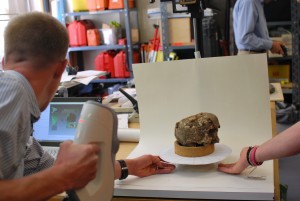Applications are now welcome for the 2016 Ipplepen field season (from Monday 6th June to Friday 1st July). Participants must enjoy working outdoors in all weathers and must commit to spending a week at the site. To apply, email danielle.c.wootton@exeter.ac.uk by 9am on Monday, 16 May with a covering letter of no more than 200 words explaining why you would like to be considered and stating a preference for weeks 1, 2 or 3. Participants with previous experience are encouraged to apply for week 4.
Category: 2016
Cereals
The post-excavation analysis of soil samples collected during the 2015 excavation season has produced important information about arable farming at Ipplepen. Exeter student Jan Oke, has examined all of the plant macrofossils obtained from these samples under a microscope. She has revealed that overall 59% of identifiable grains are wheat, 21% are barley, and 20% oats. This pattern of mixed arable agriculture is typical for South West Britain during the Roman period.
3D scanning of skulls

As at most sites in Devon, the soil type at Ipplepen is fairly acidic. This isn’t great for bone preservation as bones and other organic materials usually deteriorate more quickly than in less acidic soils. Whilst many of the excavated skeletons at Ipplepen are very fragile, we were very lucky to have the level of preservation we did in comparison to other Devon sites, where very little organic material remains at all. This makes the site at Ipplepen very important as it has provided an opportunity for researchers to understand more about the people who lived in Devon hundreds of years ago. Many of the skulls had to be delicately block lifted and have subsequently been carefully and skilfully excavated by Exeter students in the labs here in the archaeology department (special thanks to Enfys O’Doherty who has carried out the bulk of this work). However, they remain very fragile, only held together by the soil within them and vulnerable to further degradation.
We are very fortunate here in the University of Exeter that the College of Humanities IT team have been able to 3D scan the skulls for us so that we can create a digital model of each skull. These scans enable us to:
• Preserve a true and accurate record of the size and shape of the skull, especially key features that allow us to determine sex and age (from morphological features)
• Enable future researchers to examine and re-evaluate the skulls.
• Create a 3D print that can be handled by students in the classroom and the public at open days.
Radiocarbon dates
We’ve just had the results back from some scientific dating of the burials excavated in 2015; somewhat surprisingly all four of the burials dated so far are early medieval (6th – 8th century AD) rather than Roman! Furthermore, the radiocarbon results have now enabled us to establish that there are two clear phases of burial within the cemetery on slightly different alignments. The earliest phase, aligned close to true W-E and arranged in rows, appears to date from the 6th-7th century AD. The later phase, aligned closer to WSW-ENE and positioned closer to the road, sometimes clipping the edge or cut in to the fill of the roadside ditch, appears to date from the 7th and 8th centuries AD.